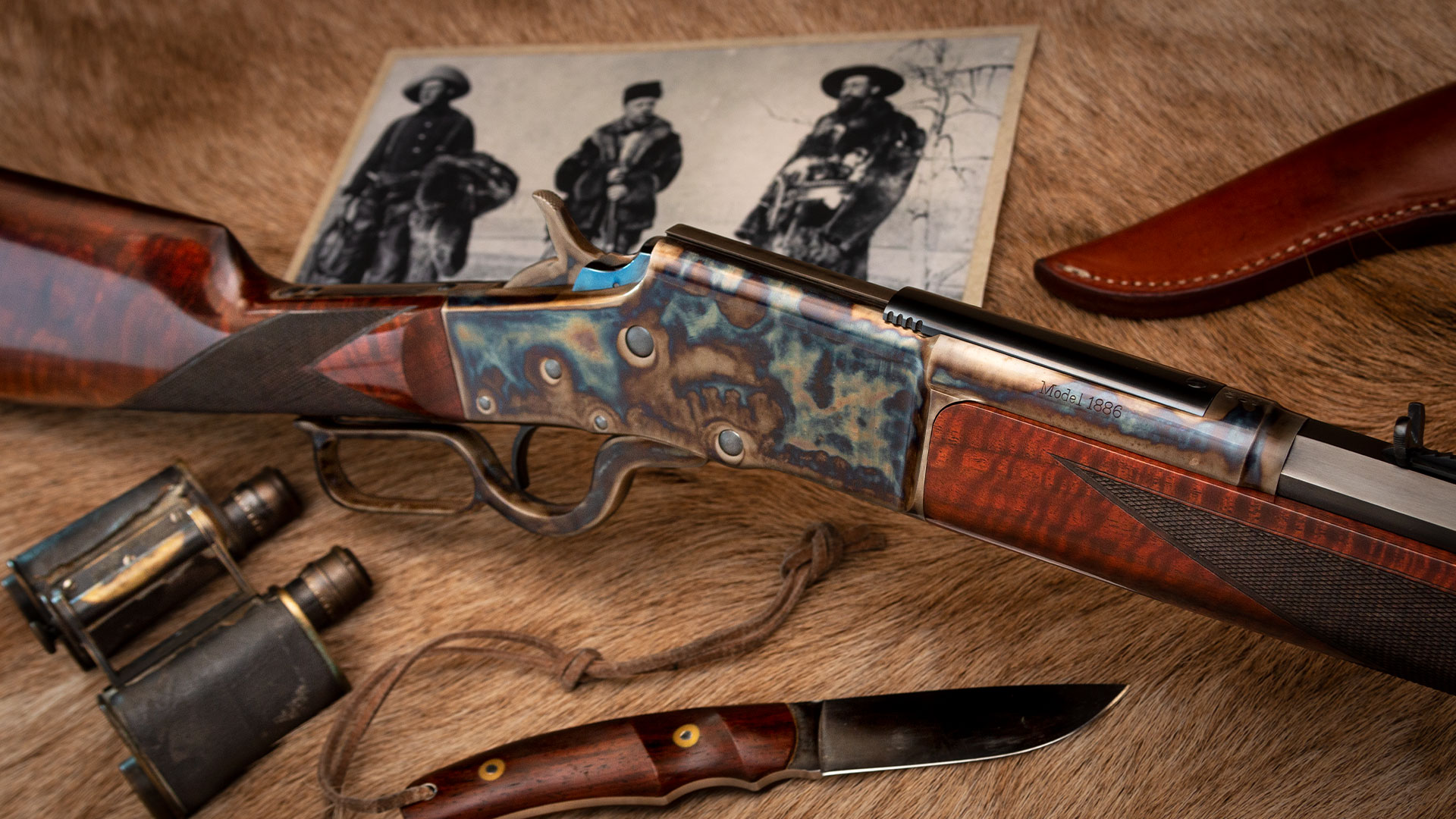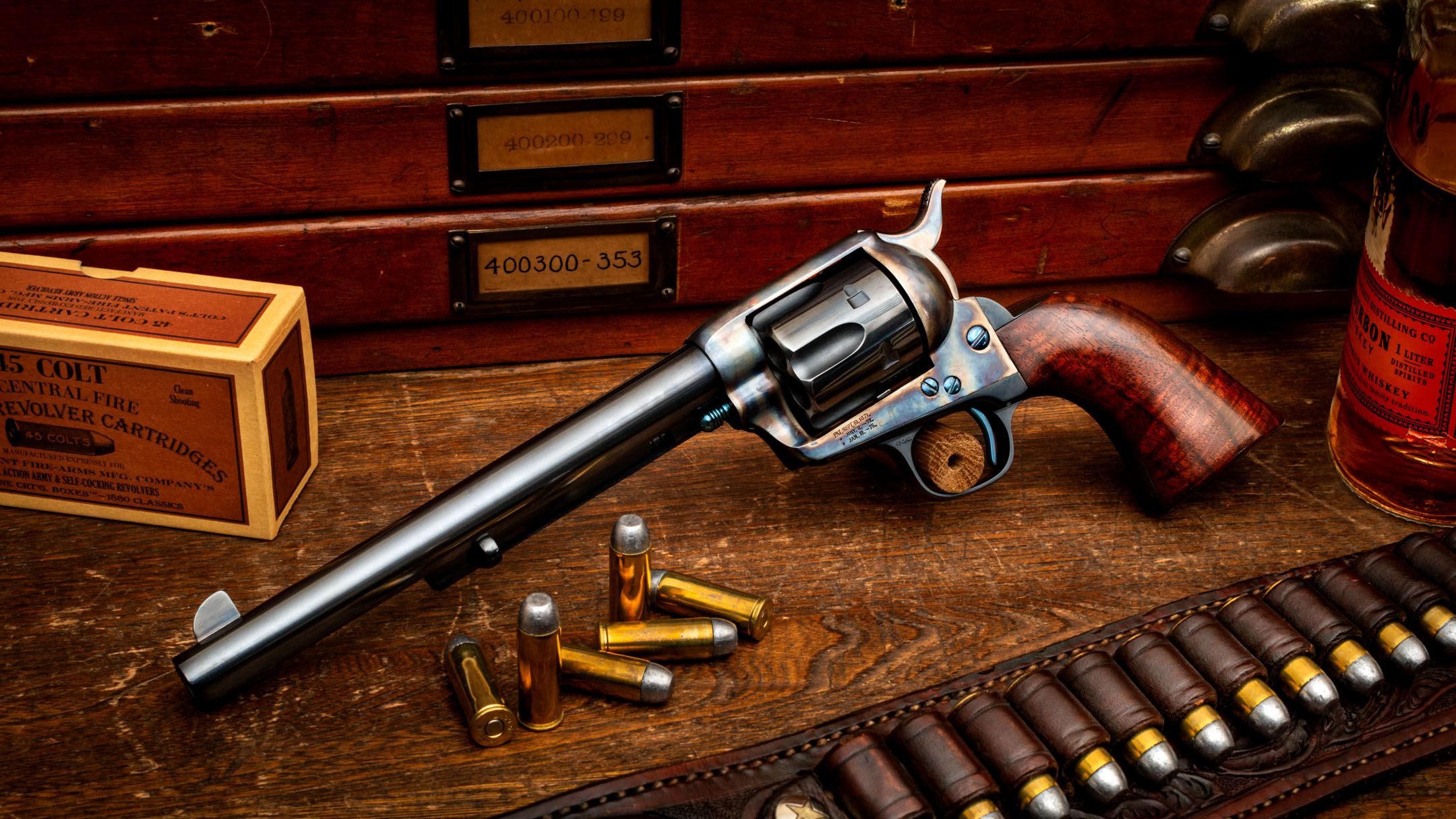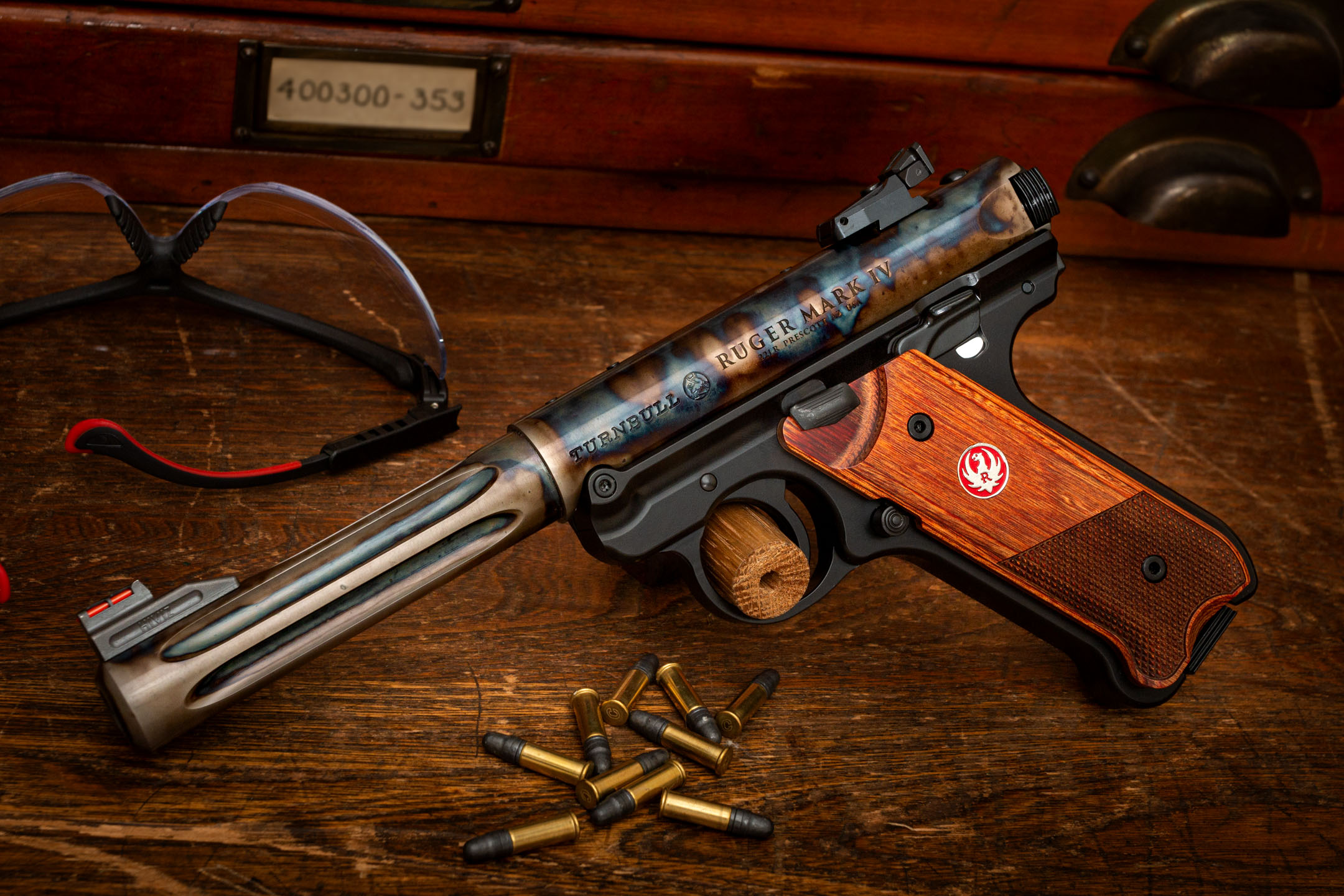Image: fully-restored Bullard Model 1886 in .40-90 Bullard. Museum grade wood and metal finishes, including period-correct bone charcoal color case hardening, by Turnbull Restoration. Visit our gallery for more restored lever action rifle examples.
Color case hardening is a time-honored process that combines both function and artistry, resulting in beautifully hardened steel with vivid, unique color patterns. While the technique dates back centuries, Turnbull Restoration has played a pivotal role in preserving and perfecting this traditional metal finish and others over the last 40 years.
We’ve dedicated ourselves to authentic restoration methods, including color case hardening, which we meticulously apply to both vintage and modern firearms. We’re driven by not only maintaining the historical integrity of firearms but by also elevating our processes into an art form.
Our hope is that the legacy of traditional, 19th-century color case hardening continues to thrive in the world of fine gunmaking. And we hope “the why” of our work is self-apparent in each restored and refashioned example we deliver to our heirloom-owning customers. But what exactly is color case hardening? And what are the other traditional metal finishing techniques we use to create period-correct restorations? Today’s article starts a four-part series where we’ll do a historical deep dive into each of the old-world metal finishes we’ve perfected: color case hardening, charcoal bluing, rust bluing and nitre bluing.
Tell us your stories.
As always, we want to hear from you! What are your stories? The comment section is open below.
In This Article:
- The Origins of Color Case Hardening
- Early Techniques and Development
- Color Case Hardening and Firearms
- The Role of Color Case Hardening in Period-Correct Gun Restoration
- The Color Case Hardening Process: A Step-by-Step Guide
- The Beauty and Practicality of Color Case Hardening
- Modern Use of Color Case Hardening
- Traditional Color Case Hardening: Always and Forever
- Related Content
- Share Your Stories
- Subscribe to Our Newsletter
Color case hardening, also known simply as case hardening, dates back to the early days of metalworking. The technique is believed to have originated by European blacksmiths during the 17th century. Originally developed as a method to improve the durability of iron tools and weapons, it became increasingly popular in the 18th and 19th centuries. The process involves infusing the surface of the metal with carbon to create a hard outer layer while maintaining a softer, ductile core. This combination of hardness and toughness made it ideal for use in firearms, which require both strength and resilience.
In its early forms, color case hardening was a relatively simple process. Blacksmiths would pack iron or steel parts in a carbon-rich medium, such as bone charcoal, leather, or hoof shavings, and then heat them in a forge. The high temperatures would cause the carbon to diffuse into the surface of the metal, creating a hard outer layer. After heating, the parts were quenched in water or oil to lock in the hardness.
As techniques evolved, artisans discovered that varying the composition of the carbon-rich medium and the quenching process could produce stunning color patterns on the metal’s surface. These colors, ranging from deep blues and purples to vibrant yellows and greens, were not just decorative but also indicated the quality and depth of the hardening.
|| Back to table of contents. || Finding our article helpful? Enter your email address to receive updates. ||
Image: restored Colt Single Action Army revolver from 1884. Visit our gallery for more restored Colt SAA examples.
When was color case hardening first used on rifles, handguns and shotguns?
The use of color case hardening on firearms can be traced back to the late 18th century. The process was refined as firearms became more sophisticated and intricate. Gunmakers quickly recognized the advantages of this technique for improving the durability of critical components such as receivers, hammers, and triggers. The aesthetic aspect, where the process leaves a vivid pattern of colors, became a signature feature, symbolizing craftsmanship and quality.
The American gun maker recognized as being the first to widely use color case hardening is Colt’s Patent Firearms Manufacturing Company, founded by Samuel Colt. During the mid-19th century, Colt began using this technique on the frames and hammers of their iconic revolvers, such as the Colt 1851 Navy and the Colt Single Action Army. Colt’s adoption of color case hardening not only provided a distinctive look to their firearms but also enhanced their durability, setting a standard for quality and craftsmanship. This innovative use of the process helped establish Colt as a premier gun maker in America and popularized the use of color case hardening in the firearms industry, influencing manufacturers like Winchester and others.
In the world of gun restoration – especially correct, museum-quality restoration – color case hardening plays a crucial role. Restoring vintage firearms to their former glory often involves re-hardening metal parts to ensure they have the appearance that is historically correct to its original period. The process requires a delicate balance of art and science, as achieving the right colors and patterns is as much about skill and experience as it is about the materials and techniques used.
One may be surprised to know that there was not one set recipe or formula for all color case hardened rifles, revolvers and side-by-side shotguns of the day. Each manufacturer was known for its own particular appearance, and that appearance would typically have variations depending on the year of manufacture. As restorers, Turnbull Restoration has exhaustive records of these particulars and variations therein based on decades of work examples that have passed through our shop.
|| Back to table of contents. || Finding our article helpful? Enter your email address to receive updates. ||
Image: period-correct polishing is the first crucial step in restoring metal parts in vintage and antique firearms. Explore the polishing chapter in our classic “Introduction to Metal Preparation” video.
How do you do color case hardening?
The process of color case hardening is intricate and requires a deep understanding of metallurgy and craftsmanship. Here’s a step-by-step overview of how it’s done:
- Materials:
- The process involves using low-carbon steel or iron as the base material. Traditionally, bone, charcoal, and sometimes leather are used as the carbon-rich materials for the hardening process.
- Procedure:
- The metal piece is packed in a sealed container with a carbon-rich material such as bone charcoal and sometimes wood charcoal.
- The container is then heated in a furnace at a high temperature. During this process, carbon from the packing material diffuses into the surface of the steel, increasing its hardness.
- After heating, the piece is quenched (rapidly cooled) in water or oil, which locks the carbon into the surface, forming a hard, wear-resistant layer. This quenching process also induces the characteristic color pattern.
- Result:
- The outer surface of the steel becomes hardened and more resistant to wear, while the interior remains soft and tough, maintaining the structural integrity of the part.
- The colors and patterns result from the oxidation of the surface during quenching, which varies depending on factors such as the type of quenching medium, temperature, and specific carbon sources used.
|| Back to table of contents. || Finding our article helpful? Enter your email address to receive updates. ||
Image: a modern reproduction on the iconic Winchester Model 1892 by Turnbull Restoration. Explore more examples of our finishing work, turning modern legends into future heirlooms.
Color case hardening is a perfect blend of functionality and beauty. The hard, wear-resistant surface it creates is essential for the longevity and performance of firearms. At the same time, the stunning colors and patterns that emerge from the process add a unique, artistic touch that sets these firearms apart.
What are the practical benefits?
The primary benefit of color case hardening is the increased durability it provides. Firearms with case-hardened parts are better equipped to withstand the stresses of repeated use, reducing wear and tear on critical components. This makes them more reliable and extends their lifespan, which is particularly important for vintage firearms that may already be decades or even centuries old.
Does color case hardening create an aesthetic appeal?
The aesthetic appeal of color case hardening cannot be overstated. The vibrant colors and intricate patterns that result from the process make each piece unique. Collectors and enthusiasts prize these firearms not just for their performance but also for their visual beauty. The colors are a testament to the skill and craftsmanship involved in creating them, making each gun a work of art in its own right.
Today, color case hardening is still used by some custom gunmakers. However, for them, it is largely an aesthetic choice, as modern materials and surface treatments impart the correct level of wear resistance and durability required by today’s firearms.
Some modern techniques simply replicate the look using chemical treatments or specialized coatings to mimic the traditional appearance without the need for the full hardening process.
|| Back to table of contents. || Finding our article helpful? Enter your email address to receive updates. ||
Image: a modern Ruger Mark IV featuring traditional color case hardened tube and barrel by Turnbull Restoration.
Color case hardening is more than just a metallurgical process; it’s an art form that has stood the test of time. From its origins in early metalworking to its use in gun restoration today, this technique combines practicality with beauty in a way that few others can. For those passionate about vintage firearms, understanding and appreciating the origins and process of color case hardening adds a rich layer of depth to their admiration.
Turnbull Restoration customers can rest assured that ONLY the traditional methods of color case hardening utilized by the great American makers of the late 19th and early 20th centuries will be used on their heirloom firearms.
Next month we’ll go deep with another legendary metal finishing process: charcoal bluing. Thanks for reading!
|| Back to table of contents. || Finding our article helpful? Enter your email address to receive updates. ||
Blog Posts and Articles
- Tagged: Color Case Hardening
- Tagged: Charcoal Bluing
- Tagged: Rust Bluing
- Tagged: Nitre Bluing
- Tagged: Colt
- Tagged: Colt SAA
- Tagged: Winchester
- Tagged: Winchester 1892
- Tagged: Ruger Mark IV
- Subscribe to the Turnbull Restoration Newsletter to receive content updates
Services
- Restoration: including lever-action rifles, single-action revolvers, semi-auto pistols and side-by-side shotguns
- Metal Refinishing and Engraving: including our methods that have created many custom, Ruger Mark IV examples
- Subscribe to the Turnbull Restoration Newsletter to receive service offering updates
Example Firearms
- Colt firearm restoration examples
- Winchester firearm restoration examples
- Parker shotgun restoration examples
- Subscribe to the Turnbull Restoration Newsletter to receive inventory updates






0 Comments